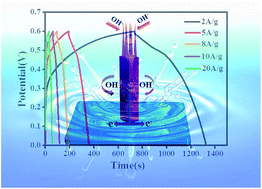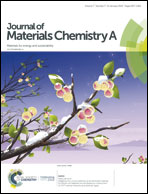Ultrahigh energy density asymmetric electrochemical capacitors based on flower-like ZnO/Co3O4 nanobundle arrays and stereotaxically constricted graphene†
Abstract
In this study, unique hierarchical flower-like ZnO/Co3O4 nanobundle arrays grown on nickel foam have been synthesized via a facile hydrothermal method. The morphology evolution of the ZnO/Co3O4 nanobundles arrays for different contents and reaction times was investigated in detail. The hierarchical structures of the ZnO/Co3O4 nanobundle arrays have a large contact area with electrolyte, and have the advantage of excellent ion diffusion and good electronic transport. Consequently, when used as supercapacitors, the ZnO/Co3O4 nanobundle array electrodes show remarkable specific capacitance of up to 1983 F g−1 at a current density of 2 A g−1 and 833 F g−1 at a higher current density of 20 A g−1, and 84.5% of the specific capacitance was still retained at 10 A g−1 after 5000 cycles. Furthermore, a ZnO/Co3O4 NBs-1//stereotaxically constricted graphene asymmetric supercapacitor device was also produced and was shown to exhibit an ultrahigh energy density of 70.4 W h kg−1 at a power density of 779.8 W kg−1. The ZnO/Co3O4 nanobundle electrodes display excellent electrochemical performance, which makes them promising electrode materials for practical application in supercapacitors.



 Please wait while we load your content...
Please wait while we load your content...